Mobs have terrorized Omaha since the city was founded in 1854. Defined as “the use of violence and intimidation in the pursuit of political aims,” terrorism was been the weapon of Omaha’s mobs from the beginning. Early on, they were seemingly concerned with horse thieves, claim jumping and break-ins. In more recent times, mobs attacked people in Omaha because of their race and ethnicities. 50 years ago, mobs lashed out at businesses. Notably, there haven’t been any mob terror trials, monuments, or other acknowledgments of the acts of the masses in Omaha throughout its 160+ years of existence.
Mob Motivations

There are many things that motivate mob terrorism, including righteous fanaticism and the mob mentality, also known as peer pressure. The acts described here are murderous terrorism that was intended to control masses of people by superseding democratic due process. Many people have argued about the difference between mob terrorism and vigilantism, saying that one is evil while the other is acceptable. I thoroughly believe that to accept that one is okay while condemning the other is hypocritical at best; at worst, it propagates the intentions of both.
Omaha Stories
There are several stories in this history of mob terrorism in Omaha. In the first one, despite a US Marshall and judge trying to stop them in 1856, an Omaha mob whipped and may have drowned two men accused of stealing horses. In the second story from 1858, a farmer said he kept losing horses. Suspecting they were being stolen, he claimed to have caught the suspects. After being stolen from jail, the men were murdered by a mob of dozens. The third story comes from 1861, when two men were arrested, one confessed and implicated the other, and a judge ordered a trial. A mob walked into the jail and murdered the one accused of being the worst, and let the other walk.
Story One: Whipped and Thrown in the River

In the summer of 1856, some settlers near Omaha bought two horses from local Pawnees. The Pawnees got them from two men selling horses nearby. When the two horses were stolen, the settlers went to the Pawnee, who explained where they got the horses from. The horse thieves were identified when they tried to sell mules to the Pawnee, who tied up the men and brought them into town.
The men They were brought to a “liberty pole” near 12th and Farnam in front of the Apex Saloon. Half of each of their heads were shaved, and one of the the accused “was stripped to the hips and his hands tied to the liberty pole” to be whipped. The Pawnee were given the chance to whip the men first, but when they hit too hard, the whips were given to the horses’ rightful owners.
The local judge demanded the whippings stop, and sent US Marshall B. P. Rankin to stop them. However, Rankin barely did anything and the whippings continued. After each man was whipped, they were thrown into the Missouri River and were never seen again.
Story Two: Vigilante Justice, or Ethnic Hatred?

The year 1858 brings the story of a farmer in Florence who kept having horses stolen. Catching the thieves in the act once, he grabbed a group of neighbors and chased them down just north of town. The two, named Harvey Braden and James Daley, were dragged by the men to Omaha and presented them to the judge there, who immediately threw them in jail to wait for a trial.
That evening, a group of dozens showed up at the jail with ropes. Pushing past the sheriff, they opened the jail with his keys and tied the ropes around the mens’ necks. Thrown into the back of a wagon, they were led to the spot two miles north of Florence where the farmer took them hostage earlier that day. Using the wagon they were brought on, the men were strung up and hung.
The sheriff rode up to Florence and got the bodies the next day. When the judge called the men of Omaha to the courthouse that day, he asked them who did it. Nobody admitted any fault, and nobody would say who else was involved. Nobody was ever accused, tried, or convicted for murdering the two men.
According to the original author, after this story was published in 1875, the truth came out that many of Omaha’s leading men from its pioneer days were involved in the lynching.
Story Three: Rob a House, Get Murdered By a Mob

George Taylor lived on Military Road northwest of Omaha in 1861. One day that spring when he’d left home, his wife reported that two men broke in, tied her up and took all the valuables in the house. The marshal heard about the crime from George Taylor, and he went looking for the men. He found two unknown men playing cards and flashing money at a saloon who seemed like they were guilty. The marshal arrested them and learned their names were James Bouve and John Iler. However, they were released when the sheriff listened to them describe the hard work they’d done to earn their pay. The marshal apologized and the men went back to drinking.
The judge told the marshal to follow the men, and he did. When he found the men walking towards the river, he immediately arrested them again and brought them to the courthouse this time. There, the judge had called George Taylor’s wife to identify the criminals. She fingered Bouve and Iler.
The next morning, this committee decided to have their own trial. They made up their own jury, then listened to Taylor’s wife. A real lawyer got up and said the law should be followed and this fake trial should be stopped. The jury found the men guilty, and asked if they should be over to the committee instead of letting them go to real court. The jury said yes, they should go to the committee. Turning to the crowd outside for a vote, they mostly agreed the committee should have their way. “…when the crowd dispersed it was pretty generally understood that the vigilance committee would have a ‘neck-tie sociable’ that very night.”That night, a “committee of men” accompanied by the marshal interrogated the men. With a gun to his face, Iler confessed they did it, and was led to the spot where the pair hid the booty.
At midnight, a crowd showed up in Omaha’s courthouse, “overpowered the marshal,” and took the men from their cells. A rumor went through the crowd that Bouve was a professional gambler and thief who’d killed several men in Colorado. Without making a confession and while cursing the crowd, Bouve was murdered. “The committee” lynched him with rope hung from a rafter in the ceiling of the courthouse. For his confession, Iler was turned loose and shot at while he ran from town.
Story Four: Stealing Land
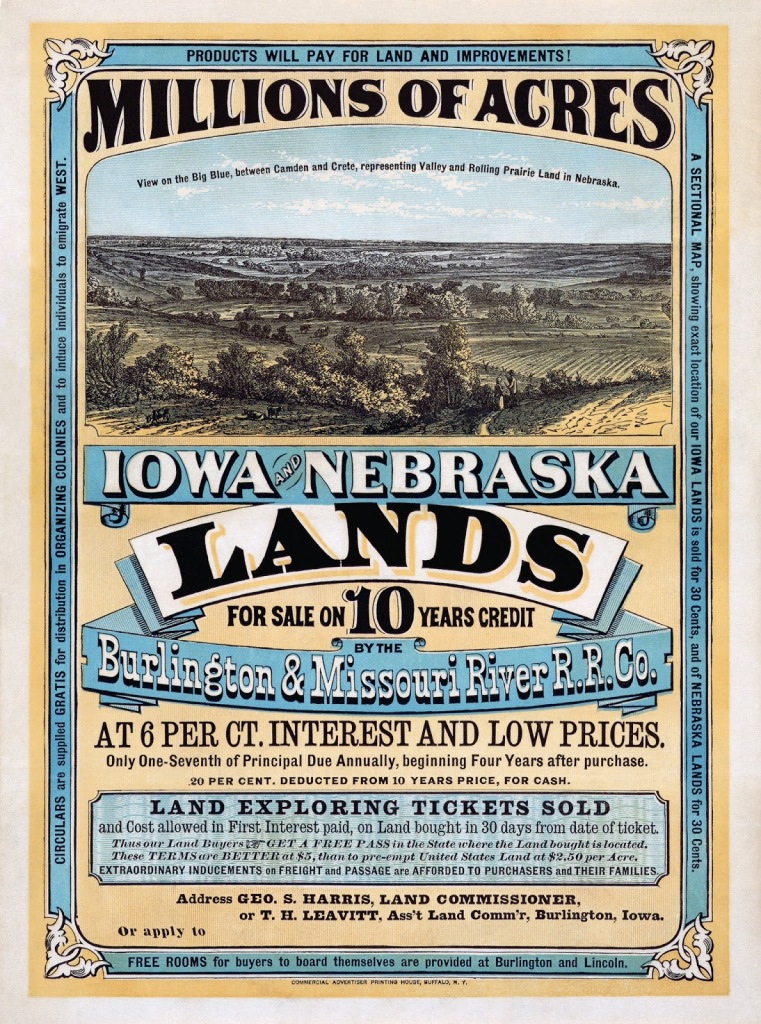
The year before the Nebraska Territory was opened for settlement, ambitious businessmen started gathering in Council Bluffs. The city’s so-called founding fathers all came from the eastern United States, often from the same towns and colleges. Seeing vast opportunity on the other side of the Missouri River, they worked together to make sure they got rich. For the most part, their schemes worked. Jacob Shull was a settler who moved to the Nebraska Territory around 1856 from back east. However, he wasn’t part of the cabal that were recognized as the founding fathers of the city. Instead, he was a regular guy who wanted a slice of the new lands. Moving to the southwest part of Omaha around present-day South 16th and Leavenworth, he staked a claim and built up his property quickly.
He likely had a house and a barn, a feeding shed and a chicken coop. Maybe there was an icehouse over a creek, and there may have been a milking barn. Shull built up his land “with several buildings.”
When he saw a mob of 100 to 150 men coming over the hill, Shull was caught completely off guard. This was the Omaha Claim Club, and they came to Shull’s house to look for him. Guessing what they were coming for, he ran. Shull made it to Omaha City where he hid in a store.
In the meantime, the ruthless mob destroyed every building on Shull’s property and burnt them all to the ground. This was meant to be a signal to anyone in Omaha who thought about claiming a stake without the mob’s permission. They eventually called themselves the Omaha Claim Club. Without the law or Army being able to stop them, they kept terrorizing the city and its new citizens for several more years. They also gave away Shull’s land to one of their men.
Shull died the next year, reportedly from stress caused by the Omaha Claim Club’s mob terrorism. On his deathbed, he told his son he’d get the land someday, and he was right. He was right, since his heirs took the person who stole his land to court, and won the deed. Shull’s Addition was platted, and his ghost was vindicated. However, the mob terrorism continued.
Story Five: Targeting Ethnicities

Despite making up almost half of the city’s population around 1900, immigrants had a really hard time getting a foothold in pioneer Omaha. After making land grabs when the Nebraska Territory was opened for settlement, the founding fathers fought hard to protect their claims, legal and otherwise. One unfortunate target was an Irish settler who was almost murdered by a mob.
In 1857, an Irish immigrant whose last name was Callahan staked a claim to land around present-day 30th and Dodge Streets. Carefully laying out his claim, he was surprised when the Omaha Claim Club mob descended on his property, too. He also ran, but unlike Shull, he came back a few days later to continue his claim.
The mob came back, and this time kidnapped Callahan. They dragged him into Omaha and held a kangaroo court trial. Of course the mob found him guilty, and founda great way to terrorize him with the verdict that either he, “he should renounce all claims to the land, or be drowned in the Missouri river.”
Callahan was very, very angry, and stuck to his ground. His face red and bloody from being beaten, imagine him raging, “I WILL NOT GIVE UP MY LAND TO YOU BASTARDS!”
Guaranteed the terrorists of the Omaha Claim Club targeted Callahan because he was Irish and not part of the eastern cabal that terrorized everyone who wasn’t aligned with their interests. The mob dragged him kicking and screaming to the river. It was February. Smashing a hole in the ice at the river’s edge, they asked Callahan if he’d give up his land. He screamed no, and they dunked him.
Bringing him out, they asked him again. Through chattering teeth and shivering bones, Callahan said no. The mob members dunked him in, and after a minute brought him out. This time Callahan’s clothes were sopping wet, and he was loosing his ability to talk. They asked him again whether he’d give up his land, and again, he refused.
The third time they dunked him, Callahan took a few minutes before he could spit out the ice water lodged in his body. He became unresponsive, so the Omaha Claim Club terrorists dragged him back to town. The quack doctors in Omaha stripped his clothes off and put him in front of a woodstove, feeding him whiskey until he came around. The mob stood in the building with papers, and as soon as Callahan regained the ability to speak, he acquiesced and signed over his land.
The mob immediately sold the land to another guy, and the issue was concerned resolved. Callahan certainly got no money. He died a few years later.
Story Six: The Busywork of Mob Violence
A year later, an Omaha mob rustled a man named Ziegler in name of claim-jumping too. Threatening him with death, the man was led off his land and to the Missouri River, where he was told to never come back. The same year, the Omaha Claim Club intervened in the affairs of a Bellevue man who was being threatened with death. Siding with the criminals, the claim club mob forced the man to sign by gunpoint and knife. They actually stripped him of his clothes to disgrace him too. This man lost after he sued a few years later.
In a separate story from the early 1860s, a different Irishman filed a claim on a piece of land where another man lived. The Omaha mob showed up when he was done, beat him up and threw him into the back of a wagon. Taking him to the land, they tied a noose around his neck and hung him, but cut him down before he died. Throwing water over him, they tried to make him sign a quit-claim, but he wouldn’t do it. They lynched him again, cutting him down again right before he died. Again, he wouldn’t sign. They did this a third time, and he still wouldn’t sign.
The Omaha Claim Club decided to torture the man instead. The mob took him to a shed and locked him up, stationing a mob guard outside the door to make sure he didn’t escape. Inside, the man starved for several days, before he was so hungry that he signed their papers. The Omaha Claim Club was proven illegal by the United States Supreme Court in 1870 – but they kept operating, albeit in different forms.
Others were a little luckier, beating the Omaha Claim Club in legal forums and otherwise. Such was the case of “Doc” George Smith whose North Omaha farm was the target of their violent machinations.
Story Seven: Skinned for the Vote
!["The Election in Omaha," Hancock Jeffersonian [newspaper, Findlay, Ohio], March 22, 1867.](https://northomahahistory.com/wp-content/uploads/2012/12/white-mob-stops-black-voting-in-omaha-march-22-1867.jpeg?w=750)
On March 4, 1867, a mob of “400 armed Democratic roughs” used revolvers to drive away twenty African American voters from the local polls while the mayor, sheriff and police force refused to protect their right to vote. According to an Ohio newspaper, “the affair was a premeditated outrage, a violation of all law and order, and a disgrace to the city and state.”
The New York Sun reported on “slips of manuscript, so miserably written as to be next to illegible, threatening the colored men with death and all manner of violence if they attempted the exercise this lawful right.” The paper went on to print the contents of one of these notes: “Notice to the Negroes of Omaha City [sic] the first Black Man that takes his Stand at the Polles to Vote he will get his head Skined to the Bone from his Enemy Watch out you g-d d–d black pupy for that pate of yours. [sic]”
The same newspaper said, “This crowd of rioters were led by two of the most notorious bullies of the city. Their followers were armed with revolvers, clubs and all sorts of weapons.” When a group of 20 Black voters arrived to vote, “they came up with the utmost quietness, conducting themselves with propriety in every way.” The group was “stopped at the gate by the rioters and utterly denied even access to the ballot box, the roughs flourishing their weapons furiously around.” A group of “a dozen law-abiding citizens were present, and saw the whole affair with shame and chagrin. But they were powerless to prevent the outrage and protect the men whose rights were thus furiously trampled under foot.”
When city officials finally appeared, “Mayor Miller declared that the negroes had no right to vote. Sheriff Dellone said the same thing. Mr. Roberts, a well known policeman, stood upon the steps of the court-house and saying the same, declared they should not vote [original emphasis].”
One African American was allowed to vote in a ward away from downtown.
Story Eight: Lynching George Smith aka Joe Coe
For instance, in 1891 a mob attacked the Omaha Courthouse in order to lynch a Black man named George Smith and called Joe Coe. Accused of attacking a white woman, Omaha’s group terrorists were inflamed when they discovered he’d been accused of raping a white woman in Council Bluffs. Not waiting for a judge, jury or any other part of the legal system, the terrorists decided what should be done.
Listening to rumors and becoming even angrier, the mob swelled with up to 10,000 people. That evening, the governor of Nebraska came to the courthouse and begged to the mob to back off – but they didn’t. The county sheriff pleaded back to the courthouse to be lynched, James E. Boyd, the governor of Nebraska, and the county sheriff both appealed to the men to disperse. Instead, by midnight a crowd of 1,000 to 10,000 people had gathered at the courthouse.
That night in 1891, the vicious mob beat Coe and dragged him through city streets. A streetcar cable at 17th and Harney Streets was used to lynch him. The crowd threw a rope over the top and raised Coe. He was dead. Omaha mayor Richard C. Cushing quickly condemned the lynching as “the most deplorable thing that has ever happened in the history of the country.”
The hateful, hurtful and disgusting history of lynching in Omaha wasn’t over yet though.
Mobs in the Early 20th Century
With the turn of the century, Omaha’s mob terrorism took a decidedly racist turn. Hyped up by Ed Rosewater’s yellow journalism and thrown into motion by Omaha’s political boss Tom Dennison, white people repeatedly took hate-filled group action designed to keep the rest of the city in check, especially anyone not seen as white.
Story Nine: Frustrated Terrorism

Starting in the 1880s, South Omaha had a large population of Greeks who all lived in an area called Greek Town. In 1909, a Greek man was accused of having a relationship with a white woman. That was illegal because Greeks weren’t seen as “white people.” Instead, they were viewed as people of color, and anyone who wasn’t white couldn’t have a relationship with a white woman. An Irish South Omaha policeman soon paid him a visit. Apparently, the Greek man ended up fighting, and taking the policeman’s weapon, the Greek man shot and killed him. Other police immediately chased and found the man, and threw him in the South Omaha jail.
Inevitably, a mob showed up outside the jail. Sneaking the man from the jail, the South Omaha police brought him to the Omaha jail for safekeeping. Along the way, the mob got a hold of the Greek more than once, trying to lynch him and being stopped by the police repeatedly. They didn’t succeed.
However, they were frustrated. Turning their hatred and bloodlust back to South Omaha, the mob terrorized the citizens of Greek Town by attacking their homes, businesses and church. They ran through tenements and apartment buildings, ransacking and looting and screaming at the Greek immigrants to leave Omaha. The mob turned to businesses, demolishing windows and looting the stores. Then they lit the torches.
Overnight, the mob burnt Greek Town to the ground. The entire Greek population was terrorized that night, and more than 1,000 fled the city. It took years for some to return, and many never did.
Story Ten: Jack Johnson Riot
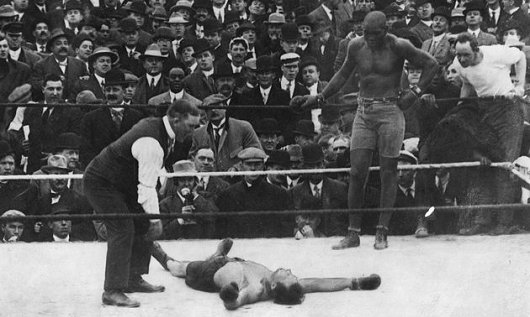
In July 1910, African American boxing great Jack Johnson fought a white guy in Reno, Nevada. Billed as the “Fight of the Century,” Jack whooped him and collected his prize. With news traveling via tickertape, the next day Omaha found out about the outcomes. A lot of men gambled a lot of money on the fight, guessing their white boxer would win.
When Jack whooped him almost immediately, the crowds in Omaha’s Sporting District went ballistic and gathered in the streets. They decided to rage against the city’s Black population. The mob attacked the Near North Side in full force, targeting any Black person on the street, throwing rocks at African Americans’ houses and terrorizing the population. That day, they killed at least one person and wounded many others.
The mobs roared stormed North Omaha’s so-called “Negro Town” in the Near North Side neighborhood. One Black man was reported dead afterward, and the riot was identified as part of a nationwide spree of anti-Black, pro-white supremacy rioting.
Mob terrorism reached a fever pitch in Omaha less than a decade later.
Story Eleven: Workers Strike Back

In the 1930s, labor union struggles resulted in riots while corporate bosses used backhanded thugs to undermine protesting.
In 1933, a large group of farmers from across eastern Nebraska converged on Omaha and started tipping over milk trucks to stop government suppression of their products’ prices. Alas, this effort was regarded as a failure.
In 1935, the streetcar drivers’ union went on street against the Omaha & Council Bluffs Street Car Company. The company and its president were vehemently anti-union and refused to negotiate with union leaders, leading to the rioting strikers to burn several cars to the ground while their long-time strike went on.
During that same decade, large groups of homeless men (aka “tramps” or “hobos” or vagrants) came through Omaha and faced police and the military.
Unionized struggles in Omaha continued for decades with strikers continuously acting as mobs to enforce their wills over their corporate enemies.
Story Twelve: Terrorism for Wealth

In 1919, a mob terrorized North Omaha in ways that continue to affect the area to this day, almost a century later.
It began when a white girl accused an African American man of assaulting her. It ended when the Army sent troops to establish a safe zone around the Near North Side. Between those two events, two days passed; the city’s mayor was hung, only to be saved in the final moments; a Black man named Will Brown was beaten, tortured, shot, lynched, decimated and burnt; a white mob nearly destroyed the brand-new Douglas County Courthouse; at least one other man was murdered; the city’s police force was overwhelmed; and the mayor’s plea to the governor to send National Guard troops fell on deaf ears.
The young woman was named Agnes Loebeck. A trial afterwards said she told police she had been walking down a street in the Near North Side during the afternoon when she was attacked by a Black man. In current times, many historians have resolved that the city’s crime boss, Tom Dennison, was responsible for everything that ensued, including prompting the girl to make a false report to police.
Regardless, the Omaha Police Department apprehended a disabled former porter named Will Brown. He was reportedly seen walking down the street at the same time Agnes had been, and he fit the description of being Black. As the police threw him in jail, a small group of “boys” immediately began collecting outside the Douglas County Courthouse. Despite repeated demands by the police to disband, the crowd grew throughout the day. When Mayor Ed Smith came out to talk to the mob, the laughed and booed him away, and then tried to lynch him. They burnt fires, looted nearby stores for guns and weapons, and attacked the courthouse.
After scaling the sides and being repelled by police forces, the mob firebombed the courthouse, which was nearly destroyed. Even today, traces of the damage have been left as a reminder and are still visible and records from early Omaha are gone forever. More than simply smashing windows or graffiti-ing on the building, the hate-filled hoard shattered souls and hope with gunshots, seething chants and nightlong horror.
Around midnight, the mob began to storm the building. As they moved to ram the front doors of the courthouse, the mayor of Omaha, Edward Smith, came out to scream at the crowd to stop. They tied a noose around his neck, dragged him to a nearby telephone post and began hoisting him to lynch him. In the last moment a car pushed through the crowd, someone hopped out and cut the mayor down, and took him to safety.
The jailers sent a note to the mob, bargaining the lives of 100 white prisoners in exchange for turning over Will Brown. They agreed to stop pillaging the courthouse, and Will Brown was sent to be murdered.
And murder they did.
After the mob lynched Brown, it was nearly dawn. While the masses abandoned downtown, a large number turned toward the Black community in the Near North Side to continue the havoc. They randomly attacked Black people on the streets and pounded on doors, smashed windows and marauded ruthlessly.
Around the same time, US Army troops from Kansas City arrived at the Union Station and marched north to Cuming Street. Setting up a perimeter around the Black neighborhood, the Army told residents that if they stayed inside the perimeter, they would stay safe from the mob. If Blacks left that zone, they couldn’t guarantee their safety. These were battle-tested soldiers and the white hordes were apparently respectful of the gatling gun and troop formations that went from North 21st Street on the east to North 30th, and from CumingStreet on the south to Locust.
This act of mob terrorism established Omaha’s harsh redlining practice, in place into the 1960s, which was a strict housing segregation practice that prevented several generations of African Americans from leaving the Near North Side neighborhood. In turn, this exacerbated the City of Omaha’s approach to Blacks, forcing a policy of benign neglect that continues to affect the community today.
Story Thirteen: More Mob Violence

Large groups of violent people continued to terrorize Omaha.
In the 1960s, a series of riots and other mob-led violence ignited North Omaha in a firebed of destruction and mayhem. The riots happened on July 4, 1966; August 1, 1966; March 4, 1968; June 24th, 1969, and June 24, 1969. There were also sporadic events with large groups of rioters, protesters and others throughout that same time period.
The last large scale mob terrorism in Omaha was July 10, 1971, when thousands of anti-war protesters gathered in Memorial Park. Despite dozens of arrests though, little damage was reported.
All this is to show that mob violence is woven tightly throughout the fabric of Omaha history. Please leave any comments below!
MY ARTICLES ON THE HISTORY OF CRIME IN NORTH OMAHA
Crimes: 1891 George Smith Lynching | 1909 Unsolved Murder | 1910 Jack Johnson Riot | 1917 Larkin McCloud Case | 1919 James Smith Death | 1919 Will Brown Lynching | 1969 Vivian Strong Killing | 1960s North Omaha Riots |
Events: Bombings | Mob Violence
Criminals: Early 20th Century Crime Bosses | Vic Walker | Ollie William Jackson | Axe Murderer Jake Bird
Related: Black Police in Omaha | Police Brutality | Antisemitism | Racism
Elsewhere in Omaha: 1906 Murder of Ed Flurry | 1899 Kidnapping of Ed Cudahy | 1890 Pinney Farm Murders
Elsewhere Online
- Early History of Omaha by Alfred Sorenson (1875)
- Greek Town Riots article on Wikipedia
- List of Riots and Civil Unrest in Omaha article on Wikipedia
- “A Horrible Lynching: The Story of Will Brown” from NebraskaStudies.org
- “Small Town, Vigilante Justice in 1907” from the Historical Crime Detective
BONUS PICS




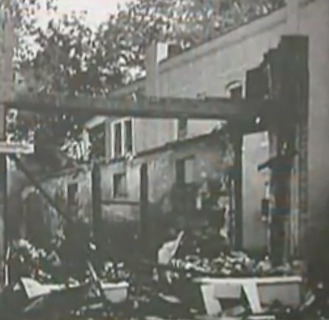


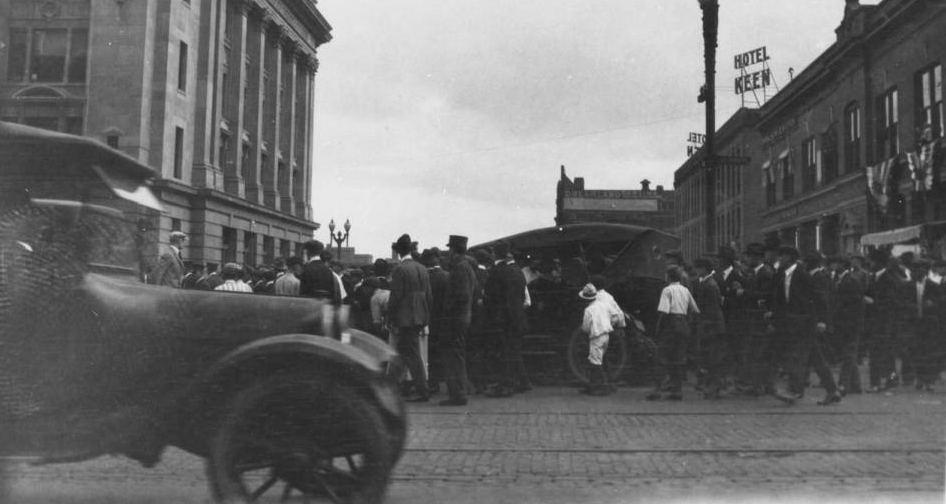
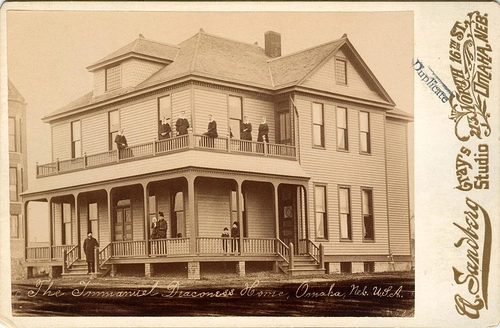

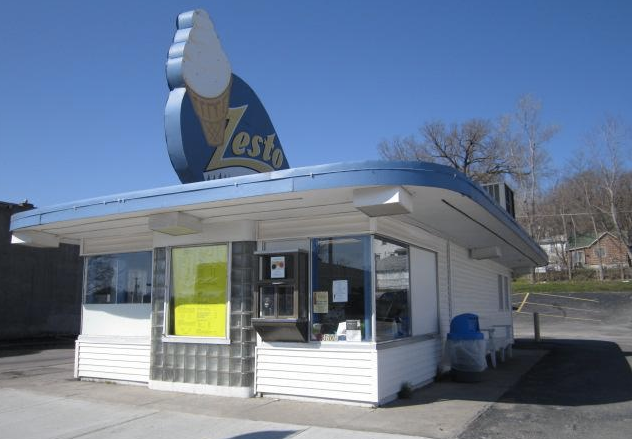
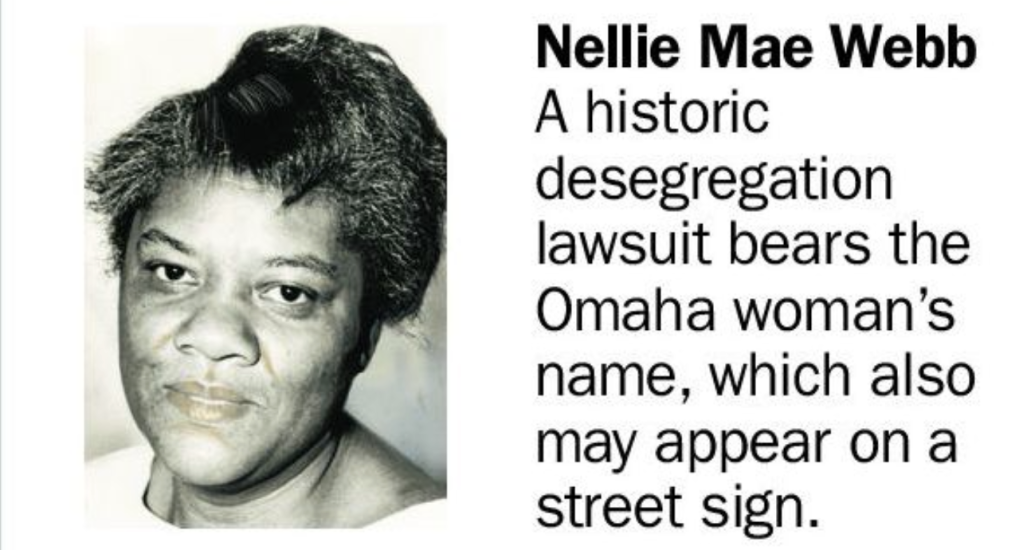
Leave a comment